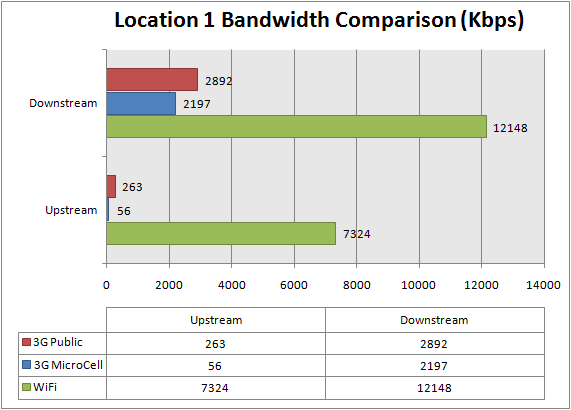AT&T 3G MicroCell: A Comprehensive Exploration
by Brian Klug on April 1, 2010 1:55 AM EST- Posted in
- Smartphones
- AT&T
- Microcell Review
- Mobile
Performance - Data
I noted a few times that I tried the device at two different residences, both for completeness sake and because they're completely different coverage-wise. Location one is relatively urban and already had excellent signal and performance; I regularly see speedtests over HSPA of nearly 5 Mbps. The internet connection here is a 20 Mbps downstream, 4 Mbps upstream DOCSIS 3.0 Cox Cable connection shared using a WRT54G-TM running Tomato. I sat in the same room as where the AT&T MicroCell was installed, my office. There's some irony in using T-Mobile's branded router (as it's sold expressly for UMA), however I use it because it has double the RAM and ROM of the WRT54GL.
Location two is more rural and doesn't have good performance or signal coverage; there are more than a few dead zones throughout the house, and I chose what I perceived to be the worst one. Internet here is Comcast Cable with 6.6 Mbps downstream, 1.1 Mbps upstream shared using a m0n0wall router running on a WRAP PC Platforms board.
I installed the microcell at both locations and let it sit for an hour. I assigned a static DHCP IP address, and then set that IP to maximum QoS priority for both upstream and downstream. For testing, I used four iPhone 3GSes, including my daily device, which is jailbroken so I can report RSSI. This is the relative signal strength reported by the baseband in arbitrary units, though still in dB. If you're rusty, remember that every factor of two change in power corresponds to 3 dB - if we go down 3 dB, we're at almost exactly half the signal. If we go up 3 dB, we're at double the power. In this case, RSSI is not dBm. As an aside, this is a much better way to gauge signal at a glance than the vague signal bar visualization; the iPhone seems to show a very optimistic moving average in its bar metric.
On the iPhone, -113 dB is effectively zero to one "bars." In fact, this seems to be the bare minimum in practice before the radio disconnects. Similarly, -51 is absolute maximum. If you put the phone next to the microcell, you'll see this, or if you're standing within line of sight very close to a macrocell. Thus in the following plot, closer to 0 is better.

For testing bandwidth, I ran tests using speedtest.net on the iPhone over 3G with and without the microcell, and over WiFi for a comparison point of my network bandwidth. Of course, we're limited to 802.11b (11 Mbps) rates on the iPhone over WiFi.


One thing that stands out doing lots of tests is that upstream performance is arbitrarily capped at exactly 58-60 kilobits/s on the MicroCell. Remember that 256 kilobits/s requirement earlier? It's obvious now where they derived that 60 kilobit/s cap from: 60 * 4 is roughly 240 kilobits/s. Add in some overhead fudge factor, and you've got 256 kilobits/s. So in the worst case, where there was previously almost no signal at all, we can now get a pretty speedy 3G data connection over the microcell. However, in the best case, at location 1, we're actually slower than before.
Remember again that AT&T's MicroCell currently only supports HSDPA speeds of up to 3.6 Mbps - at location 1 it's obvious that AT&T is running HSDPA at 7.2 Mbps, as I regularly see results like these:

Oh yeah, I'm always up that late doing bandwidth tests

Location 2 Before and After
But performance is still a function of signal strength even with the MicroCell. As you move away, you'll see speeds go from being ideal for HSDPA 3.6 Mbps all the way down to a respectable but less than ideal 1.2 Mbps.










63 Comments
View All Comments
nimck - Thursday, October 18, 2012 - link
Does anyone know how to configure the Microcell so that it's in a 'Disabled Mode' during certain hours of the day?? I'd like to lessen the radiation emission.lorace - Thursday, June 19, 2014 - link
We got the Microcell from AT&T because of poor signal strength. After it started working we were pleasantly surprised to see that our service bars had increased substantially. Now a new problem. We can't get our phones to transmit or received any picture messages. Anyone have an idea how to solve this problem? We called AT&T tech and they were clueless. lorace1@yahoo.comc21cg - Sunday, February 7, 2016 - link
i have had TWO of these crappy things, been on the phone for 17 months continously with att to get sorry help, have all the light lit up on the cell and NO service... so now what - oh and I even had to upgrade my wifi to satisfy att- hate ATT